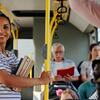As readers of the Hope blog, you likely know that 3-in-5 students experience some form of food and housing insecurity. But what you might not know is that almost 3-in-4 students experience basic needs insecurity when we expand our definition to include other basic needs like mental healthcare, transportation, and technology.
While the conversation around student basic needs security has proliferated over the past ten years, transportation still remains a lesser-discussed need. Our recently released 2023-2024 Student Basic Needs Survey Report shows that 12% of students missed class or work because of a transportation problem. That number is already too high, but when you consider how difficult unreliable transportation makes everyday tasks like child care and grocery shopping, the scope of the problem becomes larger. That number also doesn't capture the number of students who want to take college classes, but can't enroll because transportation isn't readily available to do so. After all, only 57% of community college primary campuses have transit stops within walking distance.
I spoke with Dr. Kyung (Kate) Hyun, a civil engineer and associate professor at The University of Texas, Arlington, whose research currently focuses on safety and health in transportation and community resiliency using neighborhood data, large-sized vehicle trajectories, and pedestrian and biker travel behavior.
We discussed challenges and solutions to meeting the transportation needs of college students from a civil engineering perspective.

What are some challenges you see in addressing transportation insecurities among college students?
My population [of study] is not specifically young adults or students. My work started with an older population. My thought process was that everyone is so used to driving, but eventually they have to stop because of financial, health, or other reasons… Then when I asked, “How do they cope with this?” I found all kinds of barriers—mental, physical, and more. I got into safety and health work to serve this population, but it led to my connecting with a lower-income population in Dallas.
Their workplaces are often somewhere like Walmart—and they tend to use subpar public transportation because it’s their only means. What I heard was that they often spend two hours to get to work, and spend an hour’s wage to do so. It’s good that they have access; we call it “access” when they can get to their stop within three transfers. However, they cannot always walk to get to their stops and take the transit to go to work. In some places, the last mile is broken—just totally broken [Editors note: The "last mile problem" in transportation planning refers to the often challenging issue of getting users to their final destination. Public transportation systems usually struggle more with getting users home than, say, around the city in which the system operates.] It’s not feasible at all to use Uber to get to public transport, and pay an hour’s worth of wages going to and from work or spending an hour waiting for the bus. Access is one thing, affordability is another thing, the last mile is the third thing to connect people to transportation.
We always talk about scooters, bikes, but what about people who have physical barriers? We don’t have nice sidewalks either, so it’s super dangerous in some places to get to stations.
My population has never been young adults, because we had so many young students who had a car or who carpooled to college. But here’s the problem: If they cannot travel, they’re not coming to college. They are not in the database. We don’t know that they want to come to college.
The news is talking about how the self-driving or autonomous vehicle taxi is going to change the transportation scene, but until that time comes, we need an immediate solution.

Dr. Kyung (Kate) Hyun
Civil Engineer and Associate Professor at The University of Texas, Arlington
In light of that, how can we begin to think of creative solutions for college student transportation insecurity?
I was talking to a faculty member who’s studying veteran populations—many of whom suffer physical or mental challenges with driving. So many carpool. They coordinate times around each other’s appointments and visits.
There’s no specific, standardized method because they live in a remote area. They have social connections. Veterans know each other. Maybe we can apply this same idea to student or potential student populations.
No one likes to hop in a stranger’s car, right? This is another approach with population of study—older adults. I tried to use a Facebook page to get them engaged and connected with one another—it didn’t work at all. They need more common ground to begin with.
If they know that these are their peers in college—or someone they can trust within the organization of the school—maybe that can change things. I know of volunteering organizations who do this kind of work, which could be step number one, but more opportunities for organic connections could help.
The news is talking about how the self-driving or autonomous vehicle taxi is going to change the transportation scene, but until that time comes, we need an immediate solution.
What are some of the issues in creating transportation security on the civil engineering side, and how can we begin to address them?
This is related to one of my studies I did with other faculty in social work. We did a survey for professional practitioners about their working environment. We found that everyone just works in their own silos—engineers in the engineering department, designers just designing. The whole problem is that it’s easy to overlook the angle we are talking about.
Everyone knows how to collaborate, but the true meaning of collaboration is more than just one public hearing or a workshop. We need more agency-driven initiatives doing this regularly.
When engineers and planners really look at building something like a highway, we look at where the big housing or employment centers are—not where the low-income or public transportation dependent populations live. This compounds and exacerbates public transportation issues.
To address issues with college student transportation security, we might start with what transportation planners learn in college. In engineering education, you learn first basic design components and then how to incorporate social elements. Maybe we could incorporate more steps about learning how to consider social and cultural elements in engineering design so that new engineers, when they do their designs, always think of equity, society, and community in their design work.
Do you have any examples that you’ve incorporated in your own work?
A fun story—and this is how I teach my students.
Let’s say you want to build a transit line. I’d first go out and ask people, “Where do you want this to go?” They always say things like stadiums or shopping malls—big destinations. But then I will turn back and ask, “Are you really going to use this transit once we build it?” Usually, they say no.
We’re asking the right questions to the wrong people, most of the time.
Public perception of public transportation seems to be an issue—how can we attract more riders, and therefore more support for the infrastructure for those riders?
When all you hear about public transportation is ugly events in the news, there becomes a whole perception issue.
With my older adult clients, I tell them to go experience public transportation. Take a bus and see what it looks like. It might not be fancy and sparkling, and you might encounter an unpleasant event, however, most won’t. This could reduce misconceptions about public transit.
When older adults here in Texas suddenly stop driving, they don’t know what to do, because they never used other modes of transportation. So suddenly they lose access to their doctor, their family. They’re lost. Having those initial experiences is really meaningful.
Some public education and campaigns could also be really helpful to change the stigma. In Korea, public transport is everywhere, and when we launch new programs there are always social or cultural events putting a positive perception in these systems from the start for the broader public.
How can we start to ask better questions about students’ transportation challenges?
When we deal with random trips—say, grocery shopping—everyone has a different schedule and preference. But if you’re talking about college, we can have more accurate estimates based on where people live, when they come, and when they’re going back. The uniqueness of a college campus actually helps plan because it reduces randomness.
Like the Hope survey does already, it’s a good start to ask, “Did you miss any activity?” Most of the travel services ask, “Where did you go?” and “When did you go there?” but what we really want to know is, “What trips did you miss?” and “Why?” There are so many different reasons—financial reasons are the big one, but also health, private concerns, technology.
I know most of us are using smartphones, but not everyone. I discovered recently that some students still have old phones and aren’t connected to a world based in the internet. Even some micro transit systems are very affordable, but only if you have access to the technology that makes them run—a phone, internet, wifi. And that’s also a financial concern.
I also really value in-depth interviews. Surveys prescribe your options, but young folks are really creative and could come up with different solutions. We’re different generations—some things I am comfortable with may not be well-suited for them. So ask them, “What solution would suit you?”
For more on exploring college student transportation insecurity, check out:
- Our Q&A with "CityNerd" Ray Delahanty
- Our recently published study "Advancing Transportation Solutions for Community College Students" in collaboration with The Heckscher Foundation for Children & The Kresge Foundation
We're interested in exploring and highlighting more on this crucial topic. If you're working in this area or have a unique perspective on college student transportation, email me at joshua.rudolph@temple.edu


